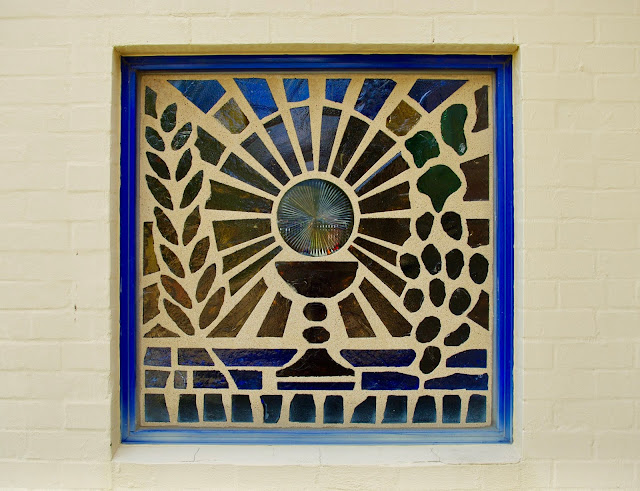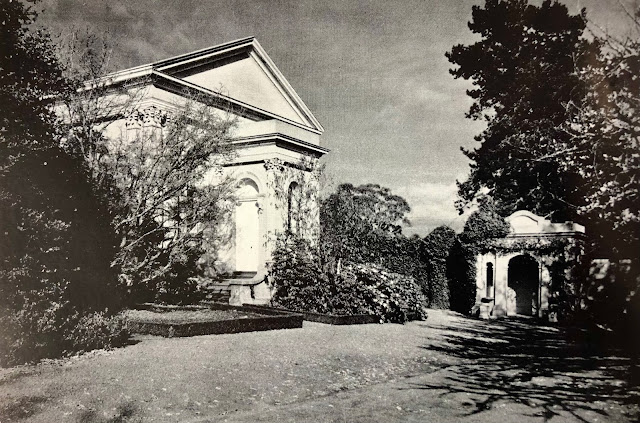No. 968 - Glenorchy - St John the Baptist Catholic Church
The city of Glenorchy is located approximately 7 kilometres north of Hobart's CBD. Glenorchy means ‘glen of tumbling waters’ and it is believed that Governor Lachlan Macquarie named the area after his wife’s birthplace; Glen Orchy, Argyllshire.The district was originally named 'King Georges Plains and the first centres of settlement were previously known as 'Kensington (Village)' and ‘O'Briens Bridge’.
St John the Baptist Catholic church is located at the head of Regina Street. It is the second Catholic church built at Glenorchy. Opening in 1960, it replaced a sandstone church on the Main road, built in 1859, which was also dedicated to St John the Baptist. [ see No. 939 ] With the rapid growth of Glenorchy after World War Two, the old church had to accomodate up to five Masses each Sunday. On occasion worship had to be held outside to accomodate parishioners.
It was these circumstances that led to the construction of a new church in 1960 on a site off Bowden Street, alongside the Holy Name School, now part of Guilford Young College’s Glenorchy Campus.
The old church was used for religious instruction for State school children until it was sold and demolished in 1963. Stone salvaged from the demolished church was intended to be used to build memorial gates at the new site but this did not eventuate.


Southerwood, W. T Planting a faith : Hobart's Catholic story in word and picture. The Author?, Hobart?, 1971.
Verrier, Cecily; From Tiny Potatoes: A Great Parish Grew, (booklet) EMS & ENS Printing, Hobart, 1999.
St John the Baptist Catholic church is located at the head of Regina Street. It is the second Catholic church built at Glenorchy. Opening in 1960, it replaced a sandstone church on the Main road, built in 1859, which was also dedicated to St John the Baptist. [ see No. 939 ] With the rapid growth of Glenorchy after World War Two, the old church had to accomodate up to five Masses each Sunday. On occasion worship had to be held outside to accomodate parishioners.
It was these circumstances that led to the construction of a new church in 1960 on a site off Bowden Street, alongside the Holy Name School, now part of Guilford Young College’s Glenorchy Campus.
The old church was used for religious instruction for State school children until it was sold and demolished in 1963. Stone salvaged from the demolished church was intended to be used to build memorial gates at the new site but this did not eventuate.
A detailed description of the new church, as it was originally build and laid-out, is found in "From Tiny Potatoes" by Cecily Verrier:
"The opening of the new church/hall occurred on 21st November 1960. Costing a modest 30,000 pounds to construct, it was a double red brick structure, with a centre aisle and two side aisles....The architects had been Cooper and Vincent. There was a chapel at right angles and this part of the church was furnished with the seats from the old St John's. At the front of the church were wooden concertina doors which could be closed over to seperate the sanctuary from the hall when it was used for other purposes... The internal wall behind the altar, as well as the external wall at the rear of the chapel were completed in sandstone. Popular belief has been that this sandstone was salvaged from the old church. As the old church was not demolished until 1963, this very appealing concept can hardly be accurate...".
Another interesting aspect of the church concerns the altar:
"The altar was a plain design with alpha and omega symbols and had been used in St Mary's Cathedral for a short time fter the sanctuary in that church was moved to its current central position".
Another feature of the church is a bell tower constructed by the Polish community in 1963 to mark the Millennium of Christianity in Poland. The bell is a small version of the historic Zygmont bell in the Cracow cathedral.
Additional information about this church is welcomed as all articles are continually updated. I can be contacted through this page or my Facebook page "Churches of Tasmania" which is linked here: Churches of Tasmania.
The church's stained-glass windows:
Another feature of the church is a bell tower constructed by the Polish community in 1963 to mark the Millennium of Christianity in Poland. The bell is a small version of the historic Zygmont bell in the Cracow cathedral.
Additional information about this church is welcomed as all articles are continually updated. I can be contacted through this page or my Facebook page "Churches of Tasmania" which is linked here: Churches of Tasmania.
The church's stained-glass windows:
In October 2023 an exhibition of Dalles De Verre (slab glass) windows took place at St. John the Baptist Catholic Church, Glenorchy. Five slab glass windows in the church are the work of artist Michael Nunn, a parishioner at the church.
The technique of creating slab-glass windows was developed in the 1930s. It differs from stained glass leadlight techniques in that it uses 25mm thick pieces of coloured glass set in cement or epoxy resin. Slabs of glass measuring 300×200x25mm thick, and called Dalles, are broken with a carbide hammer or sawn with a water-cooled diamond blade into shapes for designs. The surface of the glass is faceted by chipping to give it maximum brilliance. After cutting, the pieces of the glass design are placed into a frame and special epoxy is poured into the gaps between the glass. When the epoxy hardens and cures the finished piece is framed into a wall opening.
Since the glass used in this technique is much thicker than standard leadlight glass, the resulting colours are much more vibrant and deeper by comparison. Slab-glass windows are effective under conditions of comparatively poor lighting and are very robust in design and structure.
Michael Nunn, the artist, learnt the technique from Dom Charles Norris at Buckfast Abbey in the UK in 1989.
Information about each of the windows is provided in the captions for each photo below. The information is taken from a booklet produced for the exhibition. Photographs were taken by Denice Walter and reproduced with the permission of the artist.


 |
| The church and tower in 1963. The building has since been significantly altered. source: From Tiny Potatoes. |
THE CHURCH WINDOWS
1. The first of the windows to be designed and installed is the Holy Spirit window. It is featured on the dividing wall between the foyer and the main body of the Church and can be viewed from either side. The window was blessed on 30 May, 1993 by the then Parish Priest, Fr Mike Delaney who had asked Michael to create the first of the Church’s slab-glass windows.
2. The Eucharist window was the next to be commissioned and was given in memory of the life and work of Dominican nun, Sister Mary Thomas OP, by her many friends and parishioners of St John's Parish. Sr. Thomas walked tirelessly around the Parish ministering to parishioners. Look for her shoe in the bottom left of the window. The window was installed on 29 August 1994 and Blessed on 3 September. Parish Priest: Fr Mike Delaney.
3. The third Church window to be designed features an open Bible, Cross and candle and symbolises the importance of the Word of God in the Christian's life. The window was installed and Blessed on 13 April, 1999. Parish Priest: Fr Greg Barker.
4. Australia's first Saint, St Mary of the Cross MacKillop, was canonised in Rome on 17 October, 2010. This beautiful window was unveiled and Blessed on the day of her canonisation by Archbishop Adrian Doyle. Fr Lawrie Moate SDB, the Parish Priest at the time.
5. The most recently installed window was created to celebrate 75 years of the presence of the Priests and Brothers of the Salesian Order of Don Bosco in Glenorchy. The memorial window was instigated by Fr Lawrie Moate SDB (past Parish Priest) and the driving force - taking the project to completion -was Fr Peter Rankin SDB, neither of whom was ever able to visit to view the installed window. The Blessing occurred on 21 November, 2021.
%20St%20John%20the%20Baptist%20Catholic%20Church%20(Glenorchy)%20(Slab%20Glass%20Window%203a).jpg) | |
%20St%20John%20the%20Baptist%20Catholic%20Church%20(Glenorchy)%20(Slab%20Glass%20Window%204).jpg) |
%20St%20John%20the%20Baptist%20Catholic%20Church%20(Glenorchy)%20(Slab%20Glass%20Window%205).jpg) | ||
%20The%20artist%20(Michael%20Nunn)%20with%20one%20of%20the%20windows.jpg) |
| The artist and parishioner,Michael Nunn. |
%20St%20John%20the%20Baptist%20Catholic%20Church%20(Glenorchy)%20(1).jpg) |
| Photograph: Denice Walter |
%20St%20John%20the%20Baptist%20Catholic%20Church%20(Glenorchy)%20(2).jpg) |
| Photograph: Denice Walter |
%20St%20John%20the%20Baptist%20Catholic%20Church%20(Glenorchy)%20(Back%20of%20Chapel).jpg) |
| Photograph: Denice Walter |
%20St%20John%20the%20Baptist%20Catholic%20Church%20(Glenorchy)%20(Pews%20in%20chapel%20from%20original%20church).jpg) |
| Photograph: Denice Walter |
%20St%20John%20the%20Baptist%20Catholic%20Church%20(Glenorchy)%20(3).jpg) |
| Photograph: Denice Walter |
Sources:
Verrier, Cecily; From Tiny Potatoes: A Great Parish Grew, (booklet) EMS & ENS Printing, Hobart, 1999.
Information provided by Denice Walter
http://cdtas.org.au/glenorchy/Home.aspx
http://cdtas.org.au/glenorchy/Home.aspx





%20St%20John%20the%20Baptist%20Catholic%20Church%20(Glenorchy)%20(Slab%20Glass%20Window%202).jpg)



Comments
Post a Comment